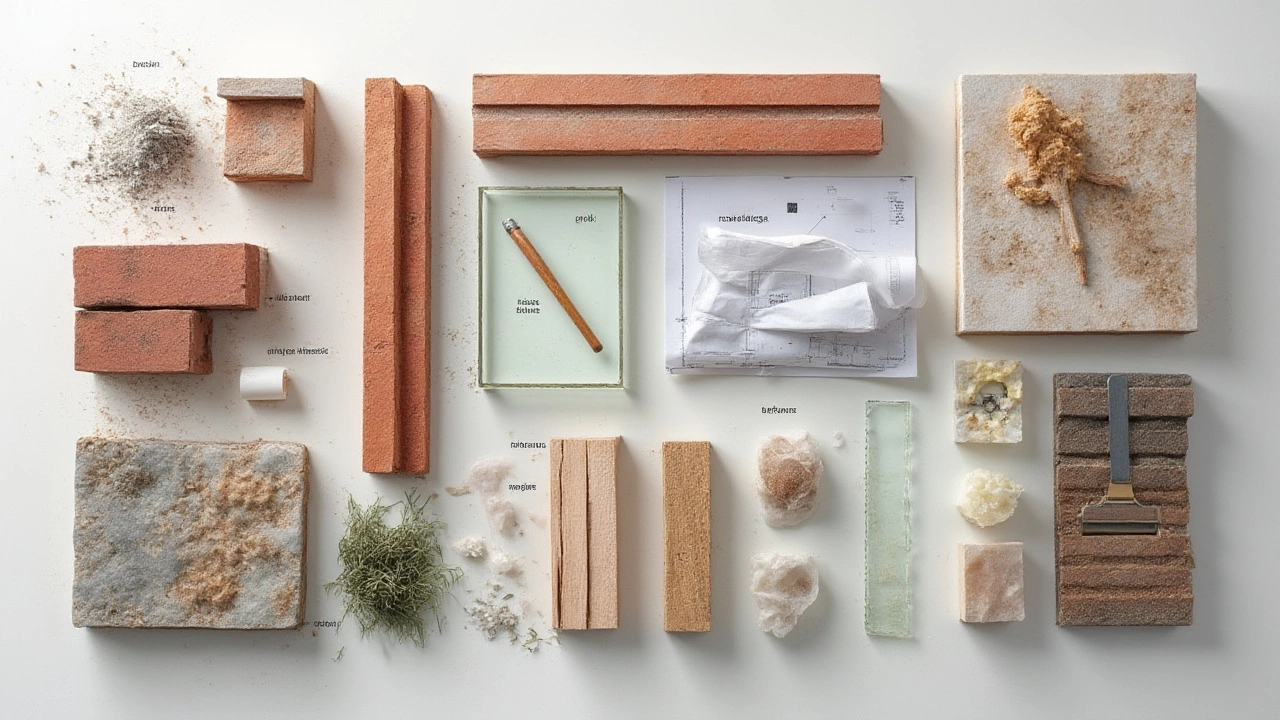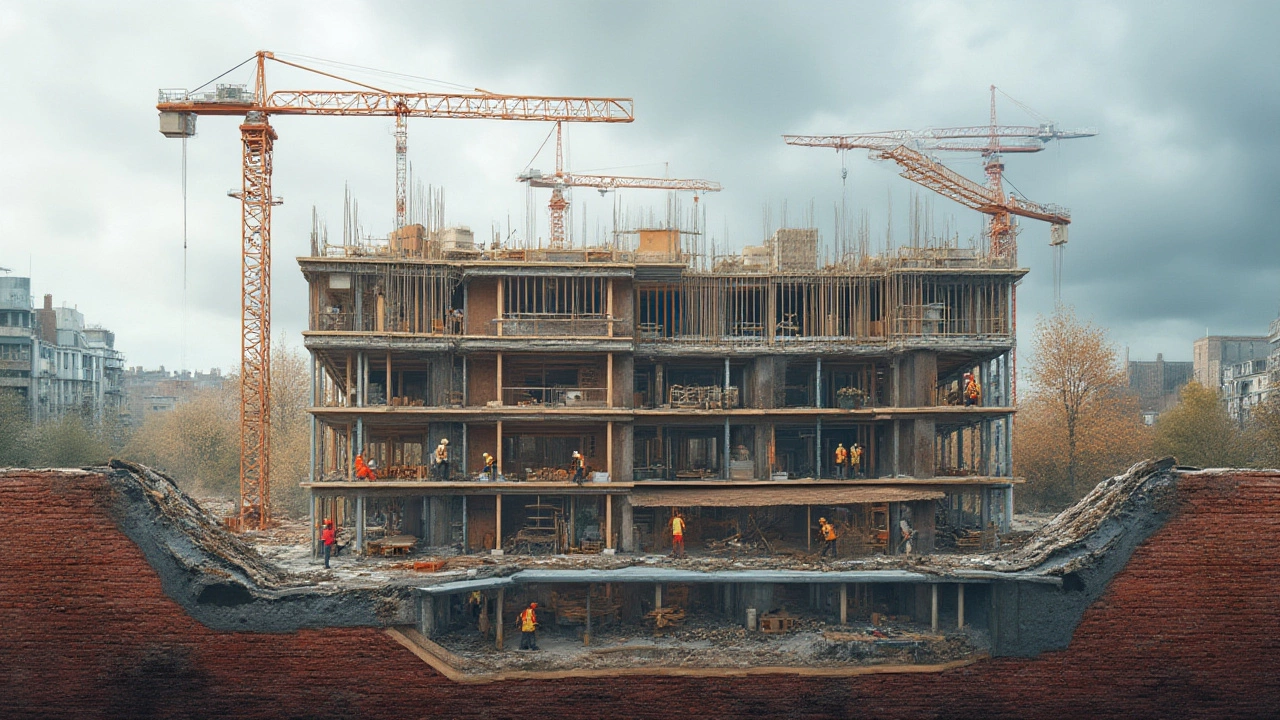Walk down any street in London or even flip through a glossy home magazine, and you’ll come face to face with the bones of our modern world—construction materials. They’re everywhere, quietly holding up houses, schools, and the odd iconic skyscraper. But what actually goes into these structures you see every day? You’d be surprised just how much is hiding behind that fresh coat of paint or sleek exterior. The world of construction isn’t just about bricks and mortar—there are centuries of trial and error, cutting-edge research, and bold innovation behind every slab, panel, and beam. If you’re considering a renovation, dreaming up a new build, or just want to avoid getting tripped up by jargon the next time you watch Grand Designs, you’ll want to get to grips with what construction material really means.
The Basics: What Counts as Construction Material?
Let’s cut through the fog. Construction materials are basically anything used to build or make up a structure—from single-family homes to bridges and airport terminals. They aren’t limited to the classics like concrete or timber. This realm includes natural materials such as clay, stone, and wood, and also manufactured products like glass, plastic composites, and steel. What sets them apart is that each material brings unique properties—some are sturdy and heavy, others flexible or light, some keep heat in, some out. Builders, architects, and engineers choose materials for specific reasons. Stone, for example, has been a staple for centuries because it’s tough as old boots. Glass, meanwhile, brings in the light but can be fragile under stress unless it’s treated. All these choices add up to a kind of recipe for each building.
Back in the day, people just used what they found around them—think mud huts, timber cabins, and stone castles. Nowadays, there’s a dizzying variety of high-tech materials made for every climate, challenge, and design whim. The biggest revolution in the past century came with the mass production of concrete and steel, which enabled those gravity-defying skyscrapers you see in city skylines. In the UK alone, a House of Commons briefing pointed out that about 200 million tons of aggregates are used each year, most of it winding up as concrete for roads, homes, and office buildings. That’s about three tons for every man, woman, and child across the country each year—imagine carrying that up your front steps!
But it’s not just about brute strength. Materials must meet all sorts of criteria: how they cope with wind and rain, fire resistance, cost, and sustainability. That’s why the definition of construction material keeps evolving. In recent years, bamboo has emerged as a surprising alternative in some projects due to its renewability and strength, and newer composites packed with recycled waste are carving out their own place. The choice isn’t static—it changes as science advances and tastes evolve.
Major Types and How They're Used
Let’s break down the main types you’ll see on sites across the UK and pretty much anywhere else you go. Each has its fans, quirks, and a perfect job it’s been honed for over the ages.
- Concrete: It’s the grand old duke of materials—ubiquitous, reliable, and strong under compression. Most new buildings, especially multi-story ones, will rely on concrete for their main load-bearing structure.
- Steel: When you need strength that doesn’t buckle under pressure, steel is the go-to. It can be molded into complex shapes and is used in everything from high-rises to bridges. It’s also having a bit of a renaissance thanks to better recycling and low-carbon processes.
- Timber: Still loved after all these years for its warmth, flexibility, and sustainability. Cross-laminated timber (CLT) can even rival steel for strength in some cases and is popping up in more modern mid-rise buildings.
- Brick and Masonry: Solid, familiar, and almost synonymous with British homes. Bricks regulate temperature well, don’t rot, and can outlast generations if well looked after.
- Glass: The signature of every modern office space and showroom. New advances mean glass can now insulate, tint itself, or even generate electricity via embedded solar cells.
- Plastic Composites: Used for insulation, piping, and sometimes cladding. They’re light, cheap, and versatile, but not always a favorite from an ecological point of view.
- Stone: Once used for everything, now more a boutique choice. Granite, marble, and limestone give buildings an enduring beauty but come at a cost, especially with labour and transportation.
If you’ve ever watched a building go up from a hole in the ground, you’ll have seen the sequence: concrete and steel for the frame, bricks for cladding, insulation tucked in next, then a skin of glass or something decorative to finish. That’s the visible mix in most modern buildings, in a nutshell.

Sustainability: Greener Choices for Building
This is where things get seriously interesting—and, frankly, a bit urgent. Construction eats up massive resources and spits out a chunk of the world’s CO2 emissions (around 39%, according to the UK Green Building Council’s figures). So, picking the right materials isn’t just a style choice; it’s about the future of our cities, and potentially the planet. Green construction materials attempt to lower the footprint. That can mean choosing products that use less energy to make (think recycled steel or glass), materials that last longer before needing to be replaced, or even ingredients that actively clean the air around them (like special photocatalytic cements now seen in some European cities).
Timber is making a real comeback, especially cross-laminated timber, which locks up carbon instead of releasing it like concrete. Rammed earth and straw bale construction sound quaint, but the science backing them is anything but. They use far less energy and keep homes surprisingly warm in winter. Bamboo is also cropping up as a super-fast-growing, renewable alternative, especially in places where it’s readily available. Plastics made from hemp fiber or reused bottles are appearing in insulation and roofing panels, showing you don’t always need to dig deeper for raw materials.
Beyond the basic material, it’s about how they’re used. Modular and prefabricated buildings slash waste by using computer-cut components, meaning less leftover offcuts headed for landfill. The UK’s push for net-zero buildings by 2050 means these eco-friendly trends aren’t going anywhere. In fact, by 2024, over 50% of new London office buildings had at least one major green feature, up from just 35% three years before, according to RICS Building Trends.
| Material | Typical Carbon Emissions (kg CO2/ton) | Main Use |
|---|---|---|
| Concrete | 700-900 | Structural frames, roads |
| Steel | 1,600-2,000 | Beams, columns |
| Timber (Softwood) | Negative (-1,800) | Frames, interiors |
| Brick | 250 | Walls |
| Bamboo | Negative | Floors, panels, frameworks |
| PVC (Plastic) | 2,600 | Piping, windows |
That table puts in black and white why timber and bamboo are so trendy—used the right way, they actually trap carbon instead of releasing it. If you’re planning a build, even swapping out parts of your construction for greener alternatives can lower your project’s impact. Look out for material certifications, too—labels like FSC (Forest Stewardship Council) for wood, Cradle to Cradle, and BRE Environmental Profiles all help filter the truly green stuff from the greenwashed.
Choosing the Right Construction Material: What to Consider
It’s not as simple as picking what looks pretty or what your builder has sitting in the van. Selecting the right construction material stacks up a lot of factors—think budget, weather, lifespan, and codes. A material that works for a sunny Kent cottage might be a nightmare for a Manchester flat or a tower block on the Thames.
- Climate and Location: In the UK, constant rain and changing seasons call for weatherproofing and insulation. Bricks, stone, and treated timber fare well, but certain metals might corrode if untreated.
- Budget: Costs fluctuate wildly. Steel remains pricey, while recycled or local materials can trim costs. But skimping on quality for savings will only come back to haunt you—think higher repairs, faster deterioration.
- Regulations and Standards: There are loads in Britain: Building Regulations, British Standards (BS), and for heritage properties, strict conservation rules. Make sure your choice meets the paperwork or risk being ordered to rip out and redo.
- Maintenance: Some materials are low-fuss, others (wood, for example) demand ongoing attention to prevent decay. Know what you’re signing up for.
- Sustainability: More buyers now factor in carbon footprint, recyclability, and even the health effects of off-gassing chemicals—nobody wants that “new house” headache.
- Speed and Ease of Construction: Prefab components or materials that require less specialist skill can move a project from paper to reality far quicker, often with less noise and mess too.
Often a mix is best. For example, a steel frame with brick cladding and a timber interior—like the “hybrid” structures now going up in London’s Old Oak Common. If you’re not sure, chat to local tradespeople or look at what’s common in your area. There’s a reason why housebuilders rely on bricks in the Home Counties but favour lightweight steel or SIP panels in many city infill projects.

Construction Materials of the Future
This isn’t just about centuries-old stones or roaring concrete mixers anymore. Some of the coolest stuff happening today sounds like science fiction. Self-healing concrete, for instance, contains bacteria that patch up small cracks whenever water seeps in, hugely extending a building’s lifespan. Transparent wood—made by stripping out lignin in timber—acts like a see-through window, only tougher. There are bricks made from recycled plastic bottles, insulation produced by mycelium (mushroom roots), and glass that swaps tint automatically depending on how strong the sun is.
Then there’s 3D printing, which means you can literally print a whole house, layer by layer, with precise control over waste and speed. The first 3D-printed house built to UK codes popped up in Lancashire back in 2024, costing a third less than a regular build and taking just a couple of weeks to assemble. Robotics and drones now help scan sites, cut panels, and even place bricks, boosting speed and reducing injuries. But the core question is always the same: how do you marry innovation with practicality? Novel materials are great, but they need to last, hit safety marks, and come in at a price regular people can afford.
The pace of change is wild. A smart homeowner or developer keeps an eye on what’s coming, not just on what’s worked in the past. Next time you walk past a building site, take a closer look at what’s being loaded in and ask yourself—what’s holding up your world? More than ever, you’re looking at a mix of old favourites and tomorrow’s breakthroughs, all stitched together by careful choice and a dose of science.
